
Andy Lloyd's Dark Star Blog

Blog 43 (October 2016)
Hillary Clinton, Her Campaign Manager and Nibiru
It is well known that Hillary Clinton's Campaign Manager, John Podesta, has more than a passing interest in Ufology (1). He has gone on record calling for UFO disclosure, and arguing that the American people can handle the truth (2). in the run-up to the U.S. Presidential election, WikiLeaks has made public thousands of Mrs. Clinton's emails, including emails from Mr Podesta. Some of these emails contain references to UFOs and/or aliens, although it has been noted that some of these are simply chance references by association, or to make a point (3). Nevertheless, given John Podesta's clear interest in the subject, some of these emails likely genuinely reflect his interest in UFOs and the possible existence of extra-terrestrial life. As we shall see, Hillary Clinton appears to share this unusual passion, and so arguably is likely to be 'in the loop' with her campaign manager's personal interest in UFOs and related subjects.

Image credit: Getty Images
One of the emails from Mr Podesta to Mrs Clinton, sent 7th September 2014, originated from a correspondent, named Don Smalter, arguing that global warming could be attributable to Planet X/Nibiru (4), and warning of a possible "near-term worldwide cataclysm ahead" (5). This appears to have been a generic email routinely sent out by campaigner Mr Smalter, which ended up in Hillary Clinton's inbox (5).
The email was sent to Clinton's campaign manager, John Podesta, as well as Senator John McCain and Professor John Holdren (6). Rather than being immediately deleted by Mr Podesta, he chose to pass it on, the reasons for which are unclear. Given his alleged general interest in conspiracy theories, he may have found the contents of the email sufficiently credible to bring to Mrs Clinton's attention. Or perhaps his interest in the email relies more heavily on the climate change issue itself, and how other people may view its causes. After all, Clinton's rival in the Presidential Race, Donald J. Trump, is a fervent climate change denier:
"The concept of global warming was created by and for the Chinese in order to make U.S. manufacturing non-competitive." (7)
There is some hard-to-verify material currently circulating that future Russian disclosure about Planet X/Nibiru hangs on the outcome of the Presidential election. Some claim, without providing any evidence I can see to back this up, that Russian President Putin is planning to provide disclosure about Planet X/Nibiru in the event that Trump loses the election (8). My efforts to authenticate the original Pravda article failed, most likely because such an article does not in fact exist, and was entirely made up by the 'reasonably accurate source' relied upon by 'Somebones' for his contentious article (8). Such tell-tale lack of verifiable sources didn't stop this story from spreading over to the British tabloid press (9,10).

Photo credit: PRG/YouTube (12)
Conspiracy theory seems to be the order of the day in the U.S. political sphere at present, largely due to Trump's extraordinary collection of claims. But that doesn't mean this is all smoke and mirrors.
In fact, Hillary Clinton has gone on record saying that she wants to investigate the truth behind the UFO phenomenon once president (11), even notably correcting the term UFO to U.A.P. -unexplained aerial phenomenon:
"The [UFO] movement viewed Mrs. Clinton’s decision to correct Mr. [Jimmy] Kimmel’s use of the term U.F.O., which some view as loaded and rooted more in science fiction than in science, as a breakthrough because it “suggested she’d been briefed by someone and is not just being flippant,” Mr. Buchman said.
"In fact, Mrs. Clinton had been briefed. She was prepped by her campaign chairman, John D. Podesta, who is not only a well-respected Washington hand, having served as a top adviser to Mr. Obama and President Bill Clinton, but also a crusader for the disclosure of government information on unexplained phenomena that could prove the existence of intelligent life outside Earth." (11)
Bill Clinton famously promised to look into UFOs before becoming president, but quickly hit a brick wall. He and his wife seem to share a common interest in the subject, alongside some highly influential friends:
"During the Clinton family seven-day vacation in August 1995 at the Rockefeller Teton Ranch outside of Jackson Hole, Wyoming, the 85-year-old billionaire [Laurence Rockerfeller] privately briefed the President and First Lady on UFOs and his hopes. No one else knows exactly what was said, but at the time Mr Clinton, who had a personal interest in UFOs and was frustrated at the lack of information he could glean on it, was carrying out a review of how the Government handled confidential material. Mrs Clinton was snapped later the same day walking through the ranch grounds deep in conversation with Rockefeller, clutching a copy of a book by Paul Davies called Are We Alone: Philosophical Implications of the Discovery of Extra-terrestrial Life." (12)
All of this would seem to make the possibility of a genuine private exchange between Hillary Clinton and her campaign manager on the subject of Nibiru rather more plausible than you might have thought.
Written by Andy Lloyd,
20th October 2016
References:
1
) Alex Berezow "WikiLeaks Reveals Hillary Clinton Campaign Manager John Podesta Believes GMOs Cause Migraines" 12 October 20162) Eli Watkins "Clinton campaign chair: 'The American people can handle the truth' on UFOs" 8th April 2016
3) Alejandro Rojas "Hillary’s campaign manager’s leaked UFO emails" 15 October 2016
4) Scott Waring "WikiLeaks Reveals Nibiru Information in Hillary Clinton Campaign Emails, UFO Sighting News" 11 October 2016
5) Don Smalter ""TELL HILLARY SHE IS WRONG ON CLIMATE CHANGE ------ see below" email correspondence sent to John Podesta, John McCain and John Holdren, 7 Sept. 2014, released into the public domain by Wikileaks
6) Jon Austin "Does Clinton believe in Nibiru? Doom planet 'proof 'in emails released by Wikileaks" 18 October 2016
7) Donald J. Trump 6 November 2016 (Twitter account since deleted)
8) Somebones "Vladimir Putin: "I will tell the World about Nibiru" 9 October 2016, and subsequent commentary dated 18th October 2016
9) Jon Austin "Are Vladimir Putin and Donald Trump teaming up to tell world about doom of Planet X?" 12 October 2016
10) Rachel O'Donoghue "‘I will warn the world about Planet X DISASTER’ Putin's stark warning over mystery world" 13 October 2016
11) Amy Chozick "Hillary Clinton Gives U.F.O. Buffs Hope She Will Open the X-Files" 10 May 2016
12) Jon Austin "What REALLY happened when Hillary and Bill Clinton tried to open UFO truths 21 years ago?" 9 March 2016
Niku, Drac and L91 Perturbed by Planet Nine...or Something Else?
Dr Konstantin Batygin and Dr Mike Brown
argue in their latest paper that the retrograde Kuiper Belt Objects Niku and Drac could have once been extended scattered disk objects (1). If you have been following these blogs during 2016, it will come as no surprise to you to hear that the influence which perturbed them into their anomalous current orbits was Planet Nine, the 10+Earth-mass planet lurking several hundred-plus Astronomical Units away, whose gravitational influence seems to be influencing the objects in and beyond the Kuiper Belt beyond Neptune (2):"Adopting the same parameters for Planet Nine as those previously invoked to explain the clustering of distant Kuiper belt orbits in physical space, we carry out a series of numerical experiments which elucidate the physical process though which highly inclined Kuiper belt objects with semi-major axes smaller than a < 100 AU are generated. The identified dynamical pathway demonstrates that enigmatic members of the Kuiper belt such as Drac and Niku are derived from the extended scattered disk of the solar system." (1)
The discovery of the unusual highly inclined Trans-Neptunian Object Niku was announced in August (3), whose unusual orbital path is similar to 2008 KV42
, nick-named Drac for its ability to climb walls (4).
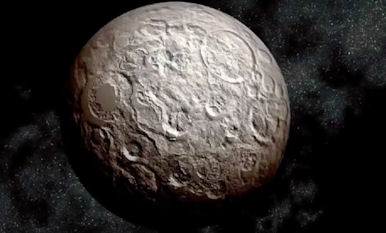
The Caltech astronomers, who are currently hunting for the elusive Planet Nine (5), have just published some dynamical calculations to demonstrate a theoretical pathway leading to the currently observed anomalous orbits of these enigmatic objects. Prior to the speculation about the existence of Planet Nine, it was thought that the two retrograde objects must have originally arisen in the inner Oort Cloud and are following a journey of gentle orbital flux which will eventually turn them into Halley-comet like objects (6).
This would appear to be the case with a new object, unofficially named L91, whose anomalous properties were also described publically for the first time today, (7). The distant object, which has a 20,000 year orbit, was first discovered back in 2013 by the Outer Solar System Origins Survey. Although its size and mass are not yet known, its orbit is truly expansive, and sits almost in the same plane as the planets.
"L91’s elliptical orbit never brings its closer to Earth than about 50 times the Earth–Sun distance (or 50 astronomical units, au). At its farthest, the object is 1,430 au away. That means its orbit is more stretched out, and centred farther from the Sun, than previously discovered worlds such as Sedna and 2012 VP113.
"The location and trajectory of L91 make it “fascinating”, said Michele Bannister, an astronomer at Queen’s University Belfast, UK. L91 may have been tossed into its remote orbit by gravitational interactions with Neptune in the distant past. “This one is right on the hairy edge of everything,” says Nathan Kaib, an astronomer at the University of Oklahoma in Norman. Bannister and her colleagues think the object may have been banished as far as 2,000AU from the Sun before it began easing its way back towards the star’s gravitational pull. L91’s orbit “is changing in quite a remarkable way”, she said." (8)
But the Caltech astronomers think otherwise, and consider these three objects to be yet more evidence for the existence of Planet Nine. There is a healthy scientific debate going on here about the possible perturbing influences that are shepherding these distant scattered objects. Possibilities include galactic tidal forces, passing stars and undiscovered planets of various sizes lurking unseen in the outer solar system. As one might imagine, astronomers have different opinions, and often find themselves drawn to particular pet theories. Sometimes science sees conviction turn to belief. Currently, in the one corner we have the Caltech team, and in the other the OSSOS team.
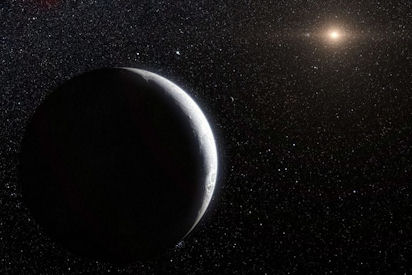
I've been keeping in touch with my 'man on the ground' at the American Astronomical Society’s Division for Planetary Science meeting in Pasadena this week about how this lively debate is going! It seems that the Caltech team have quite a way to go before the convince many of their colleagues in the astrophysics community that Planet Nine is for real. One of the points they make is that Planet Nine's effects upon the solar system are many and varied. The frequent need to bring in a large undiscovered planet to solve various anomalies and solar system riddles is an argument I have often used myself down the years. Individually, each problem which can be solved by the distant presence of Planet X does not, in itself, provide proof. But when you start to mesh together multiple anomalies, then a more comprehensive picture emerges which calls for another planet. the case for Planet X becomes compelling. Dr Mike Brown put it this way at the conference to assembled science journalists (many of whom might have been expectant of a more exciting announcement!):
“At this stage we have so many lines of evidence that there’s a massive planet out there that, if there’s not a massive planet out there, it has to be that there was one there yesterday and disappeared.” (9)
Two cases in point are two areas of research already described in previous editions of this blog, but which were more publicly aired to journalists at the conference. The first was the anomaly of the Sun's tilt (9); the second the apparent integer ratio relationship between the orbits of several extended Kuiper Belt Objects, implying orbital resonances with an as yet unidentified giant planet (10, 11). In the end, only the amassing data will provide us with the real truth, and as more of these objects are discovered and catalogued (exponentially), that truth draws rapidly closer. My bet is one something bigger and further out than Mike Brown's Planet Nine. L91 might be one of the first clues pointing to the distant perturbing influence of a highly elliptical planetary object which, at its furthest reach, brushes the very fringes of the inner Oort Cloud - an object I described in these terms over ten years ago (12).
Written by Andy Lloyd, 1
8th October 2016
References:
1)
Konstantin Batygin & Michael Brown "Generation of Highly Inclined Trans-Neptunian Objects by Planet Nine" 17 October 2016arxiv.org/pdf/1610.04992v1.pdf
2) Konstantin Batygin & Michael Brown "Evidence for a Distant Giant Planet in the Solar System" The Astronomical Journal, 151:2, 20 January 2016,
3) Ying-Tung Chen et al. "Discovery of A New Retrograde Trans-Neptunian Object: Hint of A Common Orbital Plane for Low Semi-Major Axis, High Inclination TNOs and Centaurs" The Astrophysical Journal Letters, 827(2): L24, 12 August 2016
4) Ian O'Neill "Kuiper Belt Object Travelling the Wrong Way in a one-way solar system" 5 September 2008
5) Andy Lloyd, Could Subaru Spot Nibiru? 19 September 2016
andylloyd.org/darkstarblog42.htm
6) Andy Lloyd "Going the Wrong Way Round" 14 August 2016
andylloyd.org/darkstarblog41.htm
7) Adam Mann "New icy world with 20,000-year orbit could point to Planet Nine" 17 October 2016
8) Alexandra Witze "Astronomers spot distant world in Solar System’s far reaches" 18 October 2016
9) Alan Yuhas "A possible ninth planet may be the reason for a tilt in our solar system" 19 October 2016 with thanks to Lee
10) PhysOrg "More evidence for ninth planet roaming solar system's outer fringes" 19 October 2016
11) Renu Malhotra, Kathryn Volk & Xianyu Wang "Corralling a Distant Planet with Extreme Resonant Kuiper Belt Objects," The Astrophysical Journal Letters, 824(2): L22, 15 June 2016
12) Andy Lloyd "Dark Star: The Planet X Evidence" Timeless Voyager Press 2005
Dark Star: The Planet X Evidence
New Trans-Neptunian Object may add to Planet Nine Cluster
Astronomers have announced the discovery of the third most distant object in the solar system, designated 2014 UZ224 (1). At a distance of 91.6AU, it is pipped to the title of 'most distant solar system object' by V774104 at 103AU (2), followed by the binary dwarf planet Eris at 96.2AU(3). The new scattered disk object lies approximately three times the distance of Pluto away, and may be over 1000km in diameter - potentially putting it into the dwarf planet range. Its 1140 year orbit is notably eccentric, which is becoming more expected than otherwise with this category of trans-Neptunian object.
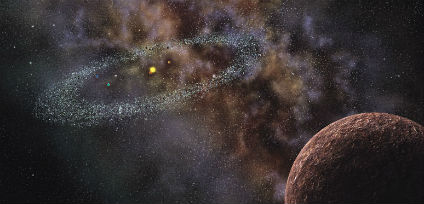
The find is a fortunate byproduct of the
Dark Energy Survey, which seems to be rather good at
picking out these dark, distant solar system objects.
It was first spotted in 2014, with follow-up
observations which have firmed up its orbital
properties, but clearly delayed the announcement of its
existence until now. These follow-up observations
were rather scatty over time, and so the Dark Energy
team, led by David Gerdes of the University of
Michigan, developed software to establish its orbital
properties:
""We often just have a single
observation of the thing, on one night," he says. "And
then two weeks later one observation, and then five
nights later another observation, and four months later
another observation. So the connecting-the-dots problem
is much more challenging."" (4)
It's a shame that data about this this object wasn't released sooner, even if that had meant its orbital properties were more vague. Speculation is already rife within the planetary science internet community that 2014 UZ224 is a contender for the Planet Nine-perturbed cluster of scattered disk objects (5), enhancing the indirect evidence for a sizeable distant Planet X object still further. Mike Brown pointed out this early conjecture on his Twitter feed (6), which gives its some credibility, but I suspect we need to wait for some of the astrophysical dynamicists to churn out the data to see if that's in fact the case.
If it turns out to be part of the anomalous cluster of
scattered disk objects, then earlier knowledge of 2014 UZ224's
existence out there would have provided another data point for computer
simulations carried out by various research groups over the course of
2016 to help pin down the whereabouts of the so-called Planet Nine.
Perhaps the team led by Dr Gerdes can be forgiven for this, as their
main research focus is on Dark Energy, rather than what's going on in
the solar system's backyard. It seems that the potential
repercussions of the discovery of 2014 UZ224
regarding Planet X were to some extent taken with a pinch of salt by the
Dark Energy team:
"‘I fell into the search for
Planet Nine almost by accident,’ Professor David Gerdes
told MailOnline. Professor Gerdes said he was
looking for a project to give his students when Planet
Nine was brought to his attention. At the moment,
Professor Gerdes and his team are going through a
process of cataloguing the objects that have been
spotted so far." (7) A student project. A
certain degree of trivialisation is evident in
these remarks! Given the
controversy that often surrounds the Planet X subject,
perhaps that is understandable. On the plus side,
there appear to be a number of other objects picked up
by their Dark Energy Survey, the details of which have
yet to be published. Hopefully, they will be soon.
Discoveries of other distant Trans-Neptunian Objects have
been published on much less information than 2014 UZ
Written by Andy Lloyd, 11-13th October 2016
References:
1) Kelly Beatty “New Object Vies for Kuiper Belt Record” 11 October 2016,
2) Eric Hand "Astronomers spot most distant object in the solar system, could point to other rogue planets" 10 November 2015
3) "Eris (Dwarf Planet)"
wikipedia.org/wiki/Eris_(dwarf_planet)
4) Joe Palca "A Friend For Pluto: Astronomers Find New Dwarf Planet In Our Solar System" 11 October 2016
5) ‘Sam’ 10 October 2016 (Yahoo Group no longer available)
6) Mike Brown 11th October 2016
7) Abigail Beale "Pluto has a new friend: The hunt for 'Planet Nine' reveals a dwarf world at the edge of our solar system" 12 October 2016
8) "V774104"
Proxima B likely to have liquid oceans
In August, I reported on rumours swirling around that an exoplanet had been discovered orbiting around our nearest stellar neighbour, the red dwarf Proxima Centauri (1). These rumours were soon confirmed (2), although the excitement was tempered by initial calculations suggesting that this world was likely to be cold with a surface temperature at a frigid -40 Celsius (3). So, there were initial hopes of a sub-surface ocean, at least, capped over by a global ice-sheet. No one's actually imaged Proxima B directly, so a lot of this is supposition, based upon the heat output of the red dwarf itself, and Proxima b's distance from it.
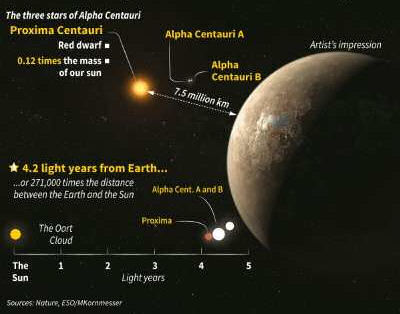
Image credit: Nature/AFP Photo/M. Kornmesser)
A new press release, made by scientists from France's CNRS research institute (le Centre National de la Recherche Scientifique), shifts the temperature of this nearby exoplanet into more pleasant, potentially habitable territory (4). The computer simulations underpinning these claims are themselves built upon assumptions, of course - in this case, that the material composition of the Proxima Centauri system is similar to our our system (5). This gave the French researchers a range of values for the radius of Proxima b. At one end of this range, the exoplanet might be a dense, rocky affair with a considerable metal core, similar to Mercury. Even so, there would be in this case the potential for a 0.05% surface water ocean (4). This is somewhat more than Earth's, and with an accompanying atmosphere, the planet would enjoy reasonable temperatures.
At the other end of the range, Proxima B is almost half as wide again as Earth, but with a substantially higher water component. In this instance, the oceans surrounding Proxima b would be up to 200km deep. Again, argue the French researchers, a more watery Proxima b would exhibit a buffering atmosphere. So, within this range is an Earth-like world, making Proxima b a prime candidate for the search for extraterrestrial life.
Again, this demonstrates the increasing importance of dwarf stars in the hunt for extraterrestrial life, showing that many of the theoretical barriers that once stood in their way are rapidly being discarded by astronomers.
Written by Andy Lloyd, 9th October 2016
References:
1) Andy Lloyd "On Proxima b" 28 August 2016
andylloyd.org/darkstarblog41.htm
2) Guillem Anglada-Escudé et al "A terrestrial planet candidate in a temperate orbit around Proxima Centauri" Nature, 536, 437–440, 25 August 2016 doi:10.1038/nature19106
3) Nicola Davis "Discovery of potentially Earth-like planet Proxima b raises hopes for life" 24 August 2016
4) AFP "Planet in star system nearest our Sun 'may have oceans'" 6 October 6 2016
5) B. Brugger et al "Possible Internal Structures and Compositions of Proxima Centauri b" ApJL, 30 September 2016
Winter is Coming
I was listening to the BBC radio the other day, and there was a discussion with a scientist about how the rising carbon dioxide level in the Earth's atmosphere was driving global warming. She compared the current mean level of over 400 parts per million to that during the last glacial period, of about 240 ppm, as a contributing factor towards the receding ice caps, and other global warming effects - one of several factors which also included orbital cycles, which could lead to glacial periods. The interviewer asked whether this raised CO2 level was in effect preventing the onset of a new Ice Age. Good question! the scientist seemed to get quite uncomfortable at this point, almost appearing to laugh the question off. Her answer was that we were not able to tell what the future would bring over these kinds of long time periods of 10s of thousands of years.
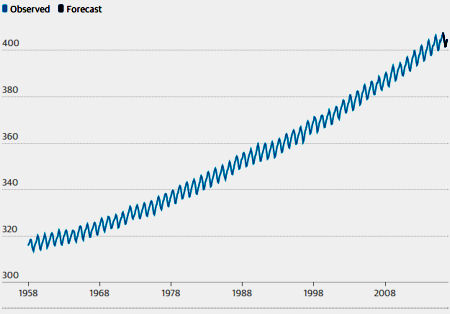
Atmospheric CO2 concentration (parts per million) over time.
Image credit: Guardian/Nature/Met Office
It's interesting, isn't it? For quite some time, the scientific consensus is that human industrial activities are driving global warming, which is a BAD thing. The apocalyptic consequences of this change over time is plainly spelt out by international organisations and leading scientists:
"The UN’s Intergovernmental Panel on Climate Change (IPCC) says that CO2 concentrations must be stabilised at 450ppm to have a fair chance of avoiding global warming above 2C, which could carry catastrophic consequences." (1)
While I believe that bad things could indeed happen with rising global temperatures, I also think that insufficient consideration is being given to the alternative prospect. We habitually speak of the 'end of the last Ice Age', but really it is not clear whether the 4 million year old Ice Epoch which we are at the tail end of has actually finished completely, or whether we are simply in the geophysical waiting room of the next glacial period/Ice Age. The tumultuous changes bringing in these ice ages are cyclical, even routine. For a large part, they depend upon astronomical cycles - the changing tilt of the Earth, procession, and the changing eccentricity of the Earth's non-circular orbit - which were first linked to significant climate changes by Milutin Milankovitch in the 1920s. With respect to these factors, we are currently moving back towards the ice, and have been for quite a while:
"The escape from Ice Age conditions, beginning 18,000 years ago, required the combined influence of all three astronomical to drag the Earth into a peak of warmth bout 6,000 years ago. Orbital eccentricity changes combined with a shift in the wobble of the Earth which made June the month of closest approach to the Sun, boosting the heat of Northern Hemisphere summers, just at a time when the tilt of our planet reached a maximum, putting that summer Sun particularly high in the sky. Since 6,000 years ago, all of these factors have turned around, and conditions for Northern Hemisphere summer warmth are becoming less favourable. the prospect is for a return of Northern Hemisphere glaciation, on a timescale of thousands of years.." (2)
Recent scientific work has illustrated how close we may be to this foreboding prospect, at least in terms of the changing nature of the Earth's orbit around the Sun - one of the Milankovitch cycles. At the moment, the northern summer as at its furthest point from the Sun, a factor which affects the amount of solar irradiation the Earth receives at the latitudes where sustainable glaciation would be triggered.
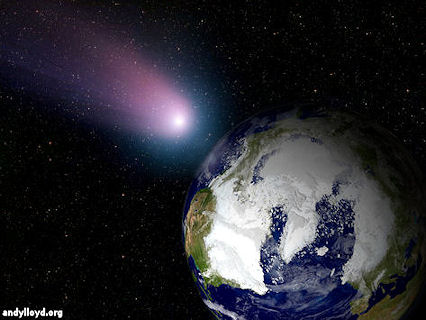
It has been proposed that the trigger point should have happened about 200 years ago, at the start of the industrial revolution, but that there is a fundamental relationship with atmospheric CO2 levels which must also be met (3). As a result of the rising CO2 level, even at that point in history, the trigger point for Northern Hemisphere glaciation was missed:
"Under normal circumstances, the interglacial would be terminated, and a new ice age would start. So, in principle, we are in the perfect conditions from an astronomical point of view. If we had a CO2 concentration of 240 parts per million (200 years ago) then an ice age could start, but luckily we had a concentration that was higher, 280ppm." (4)
Note the word 'luckily'. Suddenly, CO2 is our saviour. If it hadn't been for human activity, then, we might already be seeing ice caps extending southward in the Northern Hemisphere. The conclusion drawn is that mounting CO2 levels are likely to offset a return to ice age conditions for a very considerable period of time:
"Our simulations demonstrate that under natural conditions alone the Earth system would be expected to remain in the present delicately balanced interglacial climate state, steering clear of both large-scale glaciation of the Northern Hemisphere and its complete deglaciation, for an unusually long time." (3)
There have been times when the threat of this kind of transition seemed only too real. Another factor is the Sun's own cycles, which directly affect the amount of warming irradiation the Earth receives. One particularly cold patch in the 17th Century, during the 'Little Ice Age', is a case in point. It was at this point when the Sun reached the Maunder Minimum, a period of very low sunspot activity, culminating in the freezing over of major European rivers at the time. But scientists don't seem to have reached a consensus on the global importance of the Little Ice Age (5), or whether it even should be categorized in this way. It is agreed, however, that from the 19th Century onwards, warming and glacial retreat have been the order of the day.
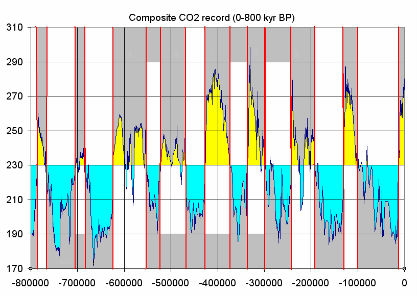
Our understanding of the Sun's complex cyclical nature is probably not yet as good as it might be. There have been suggestions that we may face a new 'Maunder Minimum' in the 2030s (6). This may be a factor offsetting the more general trend of global warming, leading to a temperature dip in the Northern Hemisphere.
So, it seems like we're living on something of a climatic knife-edge. There are multiple factors driving the Earth's climate, and several of them point towards a future Ice Age, at some point. Rising CO2 emissions seem to be pushing such a prospect further into the future than the regular glacial and interglacial cycles of the 'current' Ice Epoch suggest.
Which could be understood this way: The global warming created by human industrial activity is actually preventing us from being plunged into an Ice Age, and perhaps we should be grateful for that. This thinking is non-PC. The problem here is that Science can sometimes behave like religion; creating dogmas and consensus opinions which individual scientists feel obliged to follow. As I listened to the scientist on the radio squirm under the 'common sense' questioning, I reflected upon this: With the media predator sniffing the air, the last thing the scientist wanted was to be separated from the herd.
Written by Andy Lloyd, 31st October 2016
References:
1) Arthur Nelson "Carbon dioxide levels in atmosphere forecast to shatter milestone" 13 June 2016
2) John and Mary Gribbin "Ice Age" pp88-9, Allen Lane 2001
3) A. Ganopolski et al. "Critical Insolation - CO2 relation for Diagnosing Past and Future Glacial Inception" Nature, 529(7585):200-203, January 2016
4) Jonathan Amos "Carbon emissions 'postpone ice age'" 13 January 2016
5) John Rafferty & Stephen Jackson "Little Ice Age (LIA)" updated 18 March 2016
6) Dan Hyde "Earth heading for 'mini ice age' within 15 years: Research has predicted a new solar 'Maunder minimum' in the 2030s" 11 July 2015,
Comets, comets, everywhere...
As noted in articles above, there have been a lot of scientific publications released this month relating to the hunt for 'Planet Nine'. What has been lacking is the hoped-for announcement of its discovery. As yet, there has not been a direct observation of this proposed planet, despite the endeavours of several international teams hungry to have their names written into the history books. In particular, no announcement from Drs Brown and Batygin, despite several nights spent on the Subaru telescope (1).
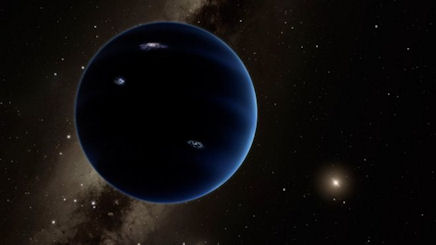
In the war of attrition between rival camps hoping to solve the mysteries of the outer solar system, backers of 'anything-but-Planet-X' seem to have edged forward. My belief is that the object is larger, and more distant than the Caltech astronomers have posited (although they did seem to leave some room open for this possibility in their original paper (2)). In which case, a substantial, distant Planet X body would be potentially affecting comets within the inner Oort Cloud, perturbing their orbits and periodically sending some our way. This thinking was used by earlier sub-brown dwarf researchers, who continue to hunt for a massive planet ~ 20,000AU distant in the outer Oort Cloud (3).
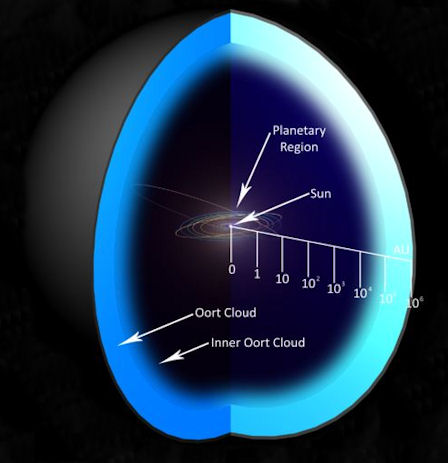
Perhaps, though, it is the much closer inner Oort Cloud
which should be scrutinised for a similar non-random
distribution of comets. The announcement of the
discovery of the distant object L91
by the Canadian Outer Solar System Origins
Survey team this month may mark a watershed moment for
objects originating from this zone as
a result of a distant brush with Planet X (4).
Recent statistical analyses, echoing the previous work
of John Matese's team (5,6), and John Murray (7), may
re-vitalise such arguments:
"Further
strategies involve examining Planet Nine’s own possible
gravitational influence on a variety of other bodies.
Astronomers Yuri Medvedev and Dmitri Vavilov at the
Institute of Applied Astronomy of the Russian Academy of
Sciences looked at 768 comets entering the solar system
for the first time, noting five that might have came
close to Planet Nine—whose gravity would have altered
their paths—sometime in the past. "Their
analysis suggests that "maybe Planet Nine made these
comets go into the solar system," Vavilov says. "We
think comets could help narrow down Planet Nine's
location. It would help to find other comets."
[Scott]
Sheppard [of the Carnegie
Institution for Science]
says he would “be wary about using
comets to help find Planet Nine, since there may be a
lot of forces besides Planet Nine that could influence
the comets' orbits. ... Still, while I'm skeptical, it
could be helpful." (8)
This latest analysis hopes to further constrain the position of the Planet X body now so keenly sought (9). Perhaps re-visiting the previous work on non-random patterns of long-period comet orbits might be helpful? The truth might lie somewhere between Caltech's Planet Nine and Matese's Tyche.
Written by Andy Lloyd, 31st October 2016
References:
1) Andy Lloyd "Could Subaru Spot Nibiru?" 19 September 2016
andylloyd.org/darkstarblog42.htm
2) K. Batygin & M. Brown "Evidence for a Distant Giant Planet in the Solar System" 20 January 2016, The Astronomical Journal, 151: 2,
3) Matese and Whitmire "Searching the WISE Preliminary Catalog for Massive Planets in the Oort Cloud" EPSC-DPS Joint Meeting 2011
4) Alexandra Witze "Astronomers spot distant world in Solar System’s far reaches" 18 October 2016
5) John Matese et al. "Cometary Evidence of a Massive Body in the Outer Oort Clouds" 1999, Icarus. 141 (2): 354
6) John Matese et al. "A Widebinary Solar Companion as a Possible Origin of Sedna-like Objects" Earth, Moon, and Planets. 97 (3–4): 459–470, 2006
7) John Murray "Arguments for the Presence of a Distant Large Undiscovered Solar System Planet", Monthly Notices of the Royal Astronomical Society, 309 (1): 31–34, 1999
8) Charles Choi "Closing in on a Giant Ghost Planet: Scientists have shrunk the hunting ground for the mysterious Planet Nine by half" 25th October 2016
scientificamerican.com article
9) Yurii Medvedev & Dmitrii Vavilov "Position of Planet X obtained from motion of near-parabolic comets" American Astronomical Society, DPS meeting #48, id.#120.01, October 2016,
Dark Star Talk
I'll be giving a talk in Cheadle, Manchester on Saturday, 28th January 2017 at 6:00 pm. The talk is to a group called "We are Change Manchester", about Planet X and the implications of its discovery upon the current paradigm.

meetup.com/WeAreChangeManchester/

You can keep informed of updates by following me on Twitter:
![]()
Or like my Facebook Page: https://www.facebook.com/darkstarandylloyd